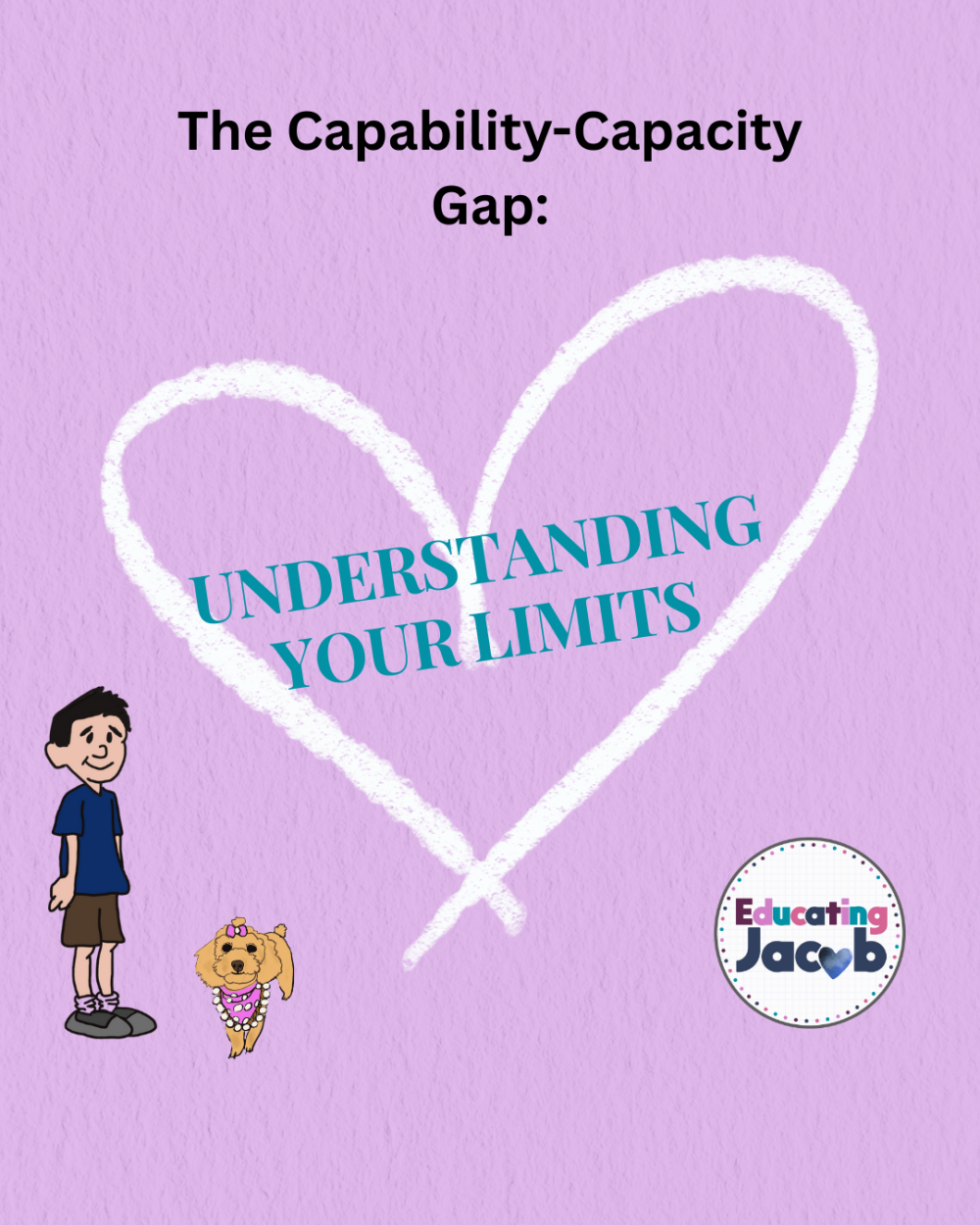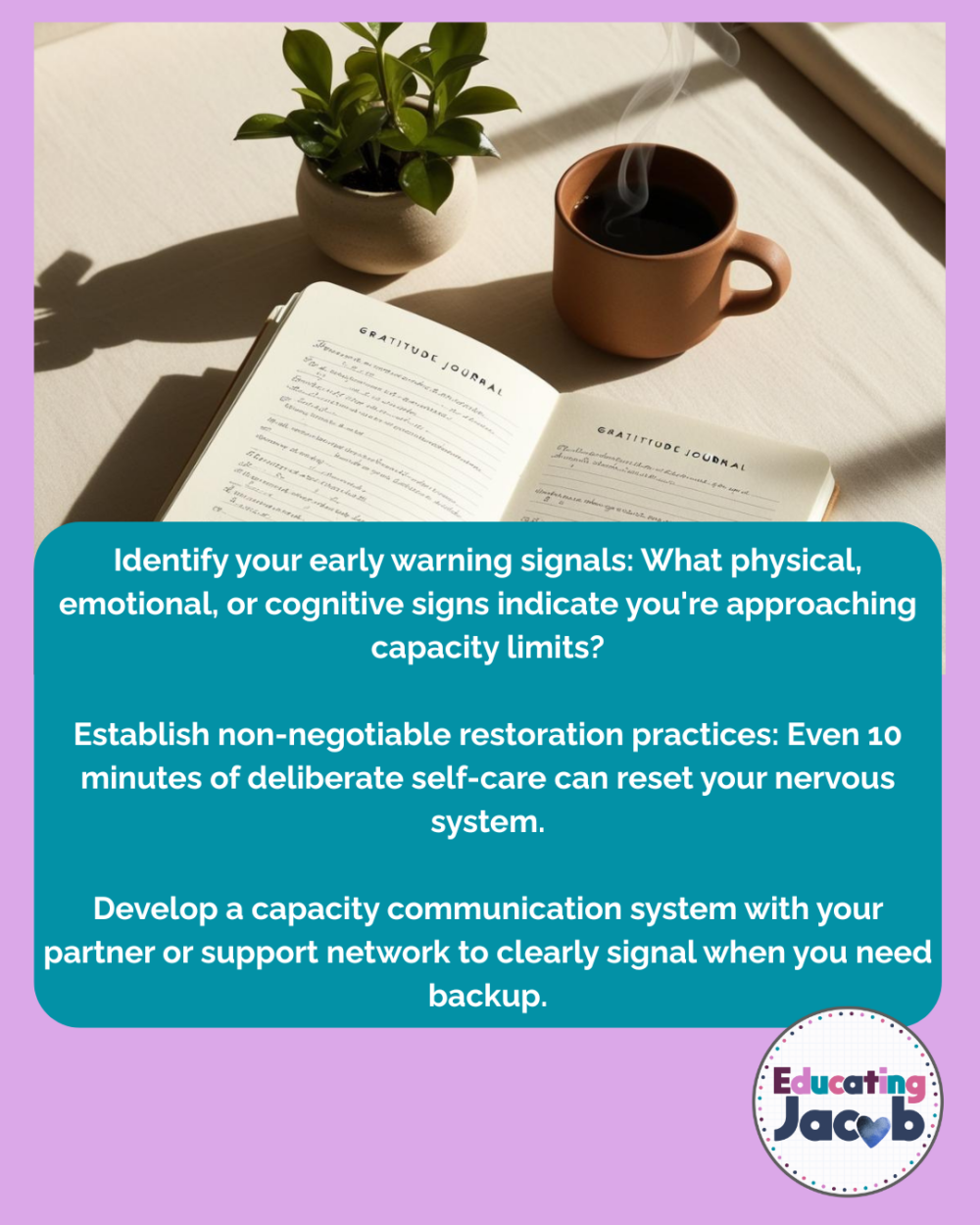Self Compassion, Navigating the Journey as Autism Parents without fear and chaos.

Navigating the Journey as Autism Parents Without Fear and Chaos
Let’s be real — parenting a child with autism isn’t just challenging; it’s transformative. It reshapes your expectations, your daily routines, and most profoundly, your relationship with yourself. When your days begin before dawn (fellow 5 AM autism warriors, I see you ☕), one truth becomes clear but is often overlooked:
Your wellbeing isn’t optional—it’s essential.
In our home, the journey of parenting Jacob revealed something unexpected: we couldn’t effectively support him without first learning to nurture ourselves—with patience, flexibility, and a deliberate practice of self-compassion. Beyond the Chaos: Scheduling 101 Class for Special Needs Children

The Capability-Capacity Gap: Understanding Your Limits
As autism parents, our capabilities are extraordinary. We navigate complex healthcare systems, become overnight experts in therapeutic approaches, defuse meltdowns in public spaces, and advocate with the tenacity of seasoned attorneys.
But capability doesn’t equal infinite capacity—and this distinction changes everything.
I navigate this landscape with ADD (making life extraordinarily colorful 🌶️ and spicy). Some mornings I’m strategizing IEP meetings with laser focus; other days I’m standing in rooms wondering what I came for. Sound familiar?
Self-compassion emerges from recognizing this gap—understanding that your capabilities remain constant even when your capacity fluctuates. The most powerful parenting skill might be giving yourself permission to acknowledge when your tank is running low.
Structured Freedom: How Visual Systems Transform Family Life
Our breakthrough came when we discovered a counterintuitive truth: structure doesn’t constrain children with autism—it liberates them.
Visual schedules transformed our daily reality. Transitions, once triggering unpredictable reactions, became navigable pathways. Jacob gained confidence through predictability. He could see what was coming, prepare mentally, and move through his day with growing independence.
The unexpected gift? We found ourselves transformed too—less anxious, more present, and better equipped to respond rather than react.
This realization forms the foundation of our CALM Framework—a comprehensive approach recognizing that exceptional parenting isn’t about perfection. It’s about creating consistent, adaptable systems that honor both your child’s neurodivergent needs and your family’s unique dynamics. Visual Schedule Hacks for autism parents, Starting 2025 CALM!
The Full-Spectrum Challenge: When Parenting Meets Adult Realities
Autism parenting happens within the complex ecosystem of adult responsibilities. We’re simultaneously managing:
- Sensory processing challenges (theirs and sometimes our own)
- Executive function demands across multiple domains
- Financial pressures and career obligations
- Relationships that require nurturing
- Household management (including the diplomatic negotiations around Jacob’s steadfast chicken-hamburger rotation 🍗🍔)
The self-compassion revolution in autism parenting begins with acknowledging this reality: you cannot perform superhuman feats indefinitely without restoration. Rest isn’t weakness—it’s strategic sustainment of your most valuable resource: yourself.
Community as Medicine: Breaking Isolation Through Connection
The research is unequivocal: parent isolation correlates directly with increased stress levels and diminished mental health outcomes. Connection isn’t a luxury—it’s a necessity.
At Educating Jacob, we’ve witnessed the transformative power of authentic community. We share unfiltered moments, celebrate small victories (yes, including Chloe the Poodle’s Easter makeover 🐩💐), and create space for both laughter and tears.

This vision inspired 👉 Autism Thrive Tribe—not merely a support group, but a collaborative learning environment where parents exchange practical wisdom, implement evidence-based strategies, and perhaps most importantly, find themselves surrounded by others who truly understand.
The profound isolation many autism parents experience isn’t inevitable. It’s a challenge we can address together through intentional community-building and shared resources.

Be kind and compassionate to one another, forgiving each other, just as in Christ God forgave you.
The Self-Compassion Revolution: Practical Steps Forward
Self-compassion isn’t abstract philosophy—it’s practical action. Consider implementing these evidence-based approaches:
- Identify your early warning signals: What physical, emotional, or cognitive signs indicate you’re approaching capacity limits?
- Establish non-negotiable restoration practices: Even 10 minutes of deliberate self-care can reset your nervous system.
- Develop a capacity communication system with your partner or support network to clearly signal when you need backup.
- Right-size your expectations on low-capacity days, focusing on essential functions rather than optimal performance.
- Document your wins, however small, to counter the negative bias our brains naturally develop during challenging periods.
You’re doing remarkable work—even when you feel overwhelmed. Even when plans derail. Even when you’re operating on minimal sleep and maximum stress.
The journey of autism parenting isn’t about achieving perfection. It’s about sustainable support, meaningful connection, and the courage to treat yourself with the same compassion you show your child every day. Check out Therapy in a nutshell for mental health tips: https://therapyinanutshell.com/how-to-build-an-internal-locus-of-control/
Join a Community That Understands
Join 👉 Autism Thrive Tribe offers more than strategies and support. It provides a sanctuary where your experiences are validated, your challenges are met with practical solutions, and your growth as both a parent and person is celebrated.
Because while this journey may have begun unexpectedly, you don’t have to walk it alone. In fact, the path becomes not just manageable but meaningful when traveled together.
Your place in this community is waiting. Come as you are—your authentic, imperfect, remarkable self—and discover how connection changes everything 💙









